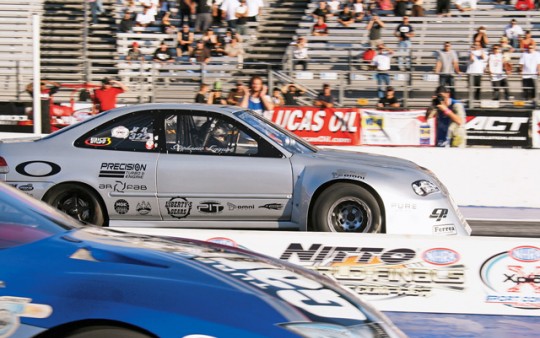Stall Torque Converters
The term stall is the condition where the impeller moves but the turbine does not. The greatest amount of stall happens when the pump impeller is driven at the maximum speed possible without moving the turbine. The engine speed at which this occurs is called the torque converter stall speed. The rpm achieved (stall speed) will be a function of the engine torque and the converter design. In general, the higher the stall, the less efficient the converter is at high speed. So why would you want a high stall converter? To allow the engine to get into the meat of the power band quicker.
A converter optimized for drag racing will have a stall speed much higher than a street converter. Allowing the engine to get into the power band quickly more than compensates for the disadvantage of lower efficiency. On a street car, the penalty in gas mileage and heat generated by a high stall converter favors a lower stall. Also, a high stall can be annoying to drive on the street because it degrades throttle response. When you stab the gas, there is a delay while the engine revs before the car starts to accelerate. To illustrate how this works, there can be up to 0.5sec or more improvement in 1/4 miles times by switching to a high stall converter. The improvement all comes in the first part of the run, and interestingly, trap speeds may decrease due to the inefficiency of the higher stall converter at high speeds.
For a street/strip car, converter stall is a compromise. For example, a given combo may need a 4,500-5,000rpm stall for the best 1/4 mile times but be annoying on the street due to excessive "slippage" but a converter which stalls at 3,000-3,500 will allow tolerable street driving without too much effect on the 1/4 mile performance. Stock converters typically stall in the 1,500-2,000rpm range. Of course, what is tolerable to one person may not be to another and vice versa. For best drag strip results, we like to see a converter that stalls close to peak torque. Some people advocate a bit above, others a bit below peak torque rpm.
Labeling a converter as having a specific stall without reference to the motor it is behind is misleading and naive. That stock converter, which stalls at ~1,500rpm behind a stock motor, might stall at 3,000rpm or more behind a blown big block, if it didn''t blow up first! To elaborate a bit: stall speed is not just a function of the converter. It is also a function of engine torque. This can be relatively easily described by defining the "K" factor. K is simply the constant in the equation K = rpm/sqrt{torque}. The equation describes the observed behavior of the converter behind a specific engine. What this allows us to do is determine what the stall speed of a given converter will be if we put it behind a different engine.
For example, if a motor has 400 ft-lbs. of torque and stalls a particular converter at 3,000rpm, K = 3,000/sqrt{400} = 150. Since we know K = 150, we can predict the new stall speed if torque is increased to say 500 ft-lbs by rearranging the equation to rpm = K*sqrt{torque}. In this case, the new stall would be rpm = 150*sqrt{500} = 3350. This formula isn''t perfect. It won''t work if the engines have wildly different torque curve, for example. And it won''t tell if a particular converter will hold together under markedly increased torque. But it gives a decent ballpark estimate and serves to illustrate a basic aspect of torque converter function.
http://image.hondatuningmagazine.com/
http://www.kennedysdynotune.com/Torque%20Converter%20Tech.htm
http://www.autoshop101.com


